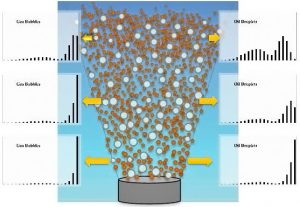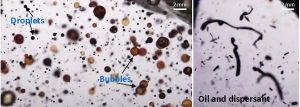Modeling Study Characterizes Droplet and Bubble Formation in Subsea Oil Spills
– JANUARY 23, 2018
Researchers developed a new formulation to simulate gas-oil interactions within a developing underwater oil plume and applied the technique to the Deepwater Horizon incident. The simulations showed that in the absence of dispersant, gas bubbles reduced the median oil droplet and bubble sizes by up to 20%, with 30 – 50% reduction observed in intermediate gas fractions. The addition of dispersant created smaller droplets and bubbles, decreasing the effect of gas bubbles on reducing their sizes. The researchers published their findings in Marine Pollution Bulletin: Droplet and bubble formation of combined oil and gas releases in subsea blowouts.
The distribution of oil droplet sizes is a determining factor in the fate and distribution of oil in an underwater spill. Smaller droplets tend to remain longer in the water column, being carried horizontally by unwater currents, and result in faster biodegradation due to their smaller surface area. Larger droplets tend to rise rapidly to the surface.
The Deepwater Horizon incident released large amounts of oil and gas in bubbly oil jets, which had very complex interactions that are difficult to predict and model. The scientists in this study have been investigating the physical processes involved with the breakup, generation, and transport of oil droplets below and above the water surface. “Understanding the interaction of oil and gas or air bubbles emerged as a major step for fully understanding the formation of oil droplets from blowouts or due to waves,” said study author Michel Boufadel.
Using their new formulation, the team updated the VDROP-J jet-droplet formation model that coupled oil droplet dynamics with gas bubble dynamics to provide the spatial distribution of droplets and bubbles along the plume. The researchers validated the updated model using laboratory and field experiment data and revisited droplet and bubble formation scenarios from the Deepwater Horizon incident.
The simulations showed that the median oil droplet size was approximately 7 mm and the median bubble droplet size was approximately 9 mm for cases with no oil and gas interactions. Coupled oil and gas flows decreased droplet size and bubble size as the gas fraction reached 50% per volume. Dispersant application resulted in an approximate five-fold decrease in droplet and bubble sizes, making droplets more resistant to break up and reducing the imparted energy of the bubbles.
The newly developed formulation is the first attempt to consider bubble effects on the droplet formation process in a three-phase plume of oil, gas, and water. The novel approach provides a quantitative means to quantify droplet and bubble size distribution and enhances the prediction of and response to underwater oil and gas blowouts.
Data are publicly available through the Gulf of Mexico Research Initiative Information & Data Cooperative (GRIIDC) at doi:10.7266/N7HH6H5Z.
The study’s authors are Lin Zhao, Michel C. Boufadel, Thomas King, Brian Robinson, Feng Gao, Scott A. Socolofsky, and Kenneth Lee.
************
This research was made possible in part by a grant from the Gulf of Mexico Research Initiative (GoMRI) to the Dispersion Research on Oil: Physics and Plankton Studies II (DROPPS II) consortium. Other funding sources included the Department of Fisheries and Ocean Canada (DFO).
The Gulf of Mexico Research Initiative (GoMRI) is a 10-year independent research program established to study the effect, and the potential associated impact, of hydrocarbon releases on the environment and public health, as well as to develop improved spill mitigation, oil detection, characterization and remediation technologies. An independent and academic 20-member Research Board makes the funding and research direction decisions to ensure the intellectual quality, effectiveness and academic independence of the GoMRI research. All research data, findings and publications will be made publicly available. The program was established through a $500 million financial commitment from BP. For more information, visit https://gulfresearchinitiative.org/.
© Copyright 2010-2018 Gulf of Mexico Research Initiative (GoMRI) – All Rights Reserved. Redistribution is encouraged with acknowledgement to the Gulf of Mexico Research Initiative (GoMRI). Please credit images and/or videos as done in each article. Questions? Contact web-content editor Nilde “Maggie” Dannreuther, Northern Gulf Institute, Mississippi State University (maggied@ngi.msstate.edu).







